Exterior - Doge's Palace / Palazzo Ducale
Venice, Italy
Palazzo Ducale - Official Website
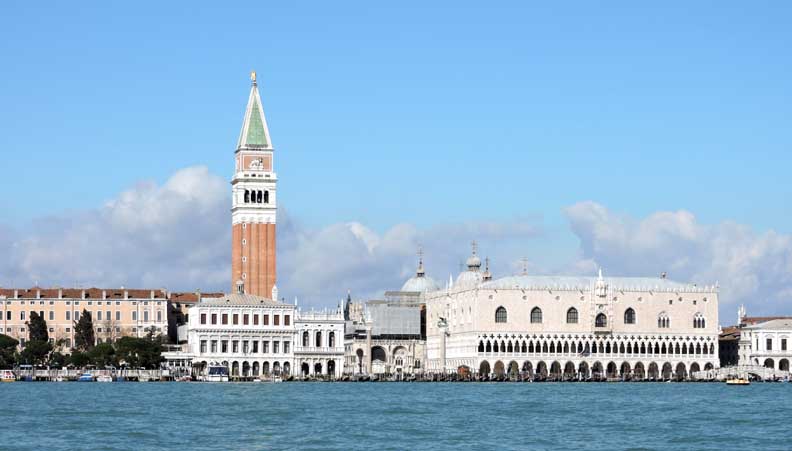 Tall building: Campanile 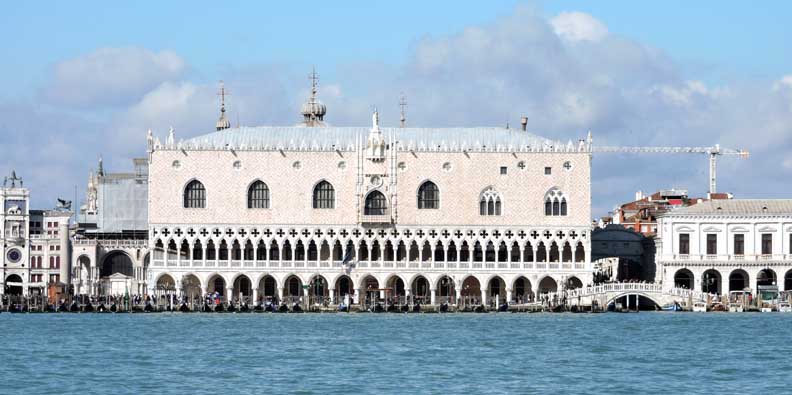 The Palace seen from the Lagoon. "The distinctive look of this masterpiece of Gothic architecture stems from the way its designers managed to suspend
the enormous solid bulk of the palace upon a double arcade of slender,
almost delicate Istrian marble columns. They achieved that visual
balance by creating a remarkably light-looking upper story, its surface
made to appear almost lacy with patterns of pink Verona marble, pierced
by graceful arching windows. The effect is nothing short of enchanting
and is enhanced by a cornice of merlons and spires that seem to make
the palace waft airily into the sky. The facade is sometimes seen as a
metaphor for the city itself, its enormous weight supported by a
foundation of wooden piles driven into the floor of the lagoon." - Barbara Radcliffe Rogers, "Exploring the Doge's Palace in
Venice: A Visitor's Guide," on PlanetWare (online Jan. 2017)
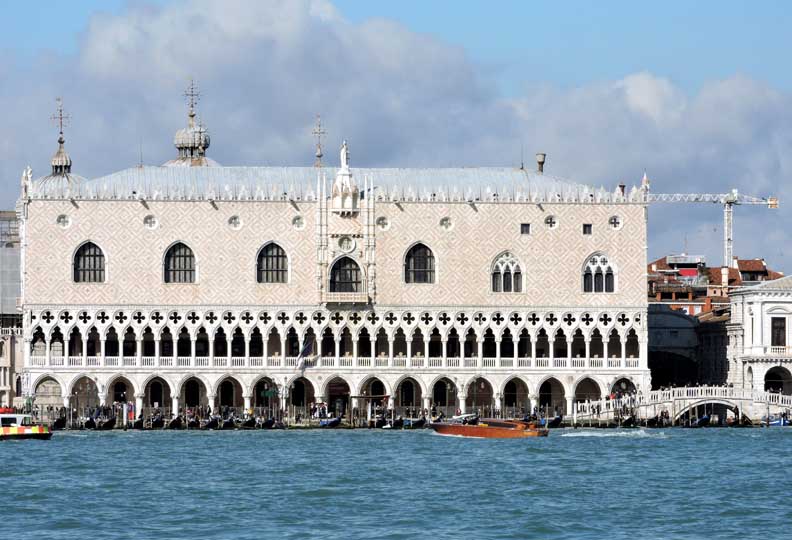 Venetian Gothic is an architectural style combining use of the Gothic lancet arch with Byzantine and Moorish architecture influences. The style originated in 14th century Venice with the confluence of Byzantine styles from Constantinople, Arab influences from Moorish Spain and early Gothic forms from mainland Italy.. ... Note bridge at right (detailed below:) 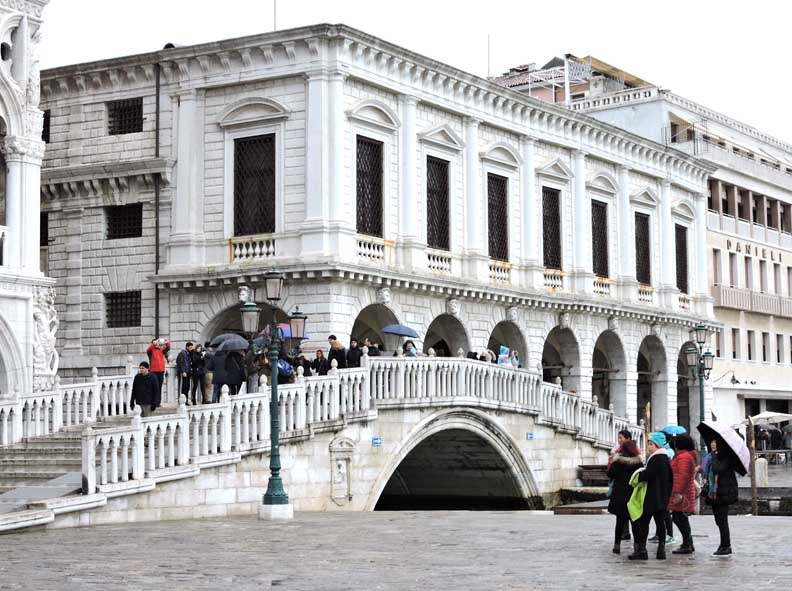 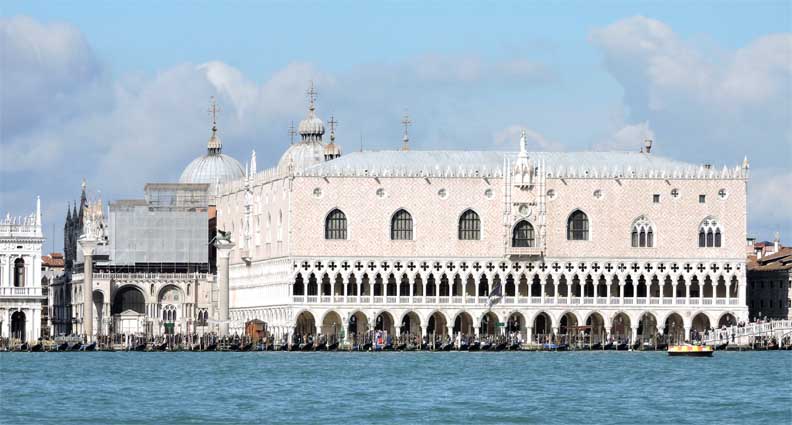 "The upper story of the facade features a diamond pattern of colored stone, a technique that was a hallmark of late Byzantine architecture. The openwork (lattice-like carving) and arcades of the bottom two levels combine Islamic and Gothic influences ....
As a result of its unique cultural and geographic position,
fourteenth-century Venetian architecture - as exemplified by the Palazzo
Ducale - is a beautiful hybrid of Byzantine, Islamic, and Gothic
cultures, which are all bound together within a blossoming Venetian
Renaissance architectural tradition." - Dr. Ellen Hurst, "Palazzo Ducale," pub. on Kahn Academy (online Jan. 2017)
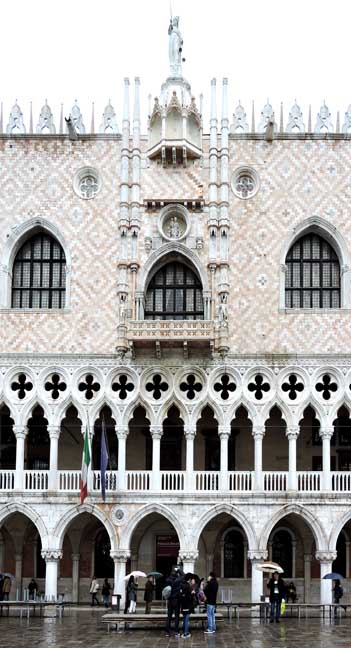 Third level: Byzantine patterned stone ... Second level: balcony with quatrefoils atop columns ... Balustrade
"The facades include a lower section consisting of a ground floor colonnade beneath an open [second floor] loggia. Unlike many other medieval era palaces, here at the Palazzo Ducale, the loggias are below while the solid walls are above. Architectural expects claim this gives the structure the 'light' feeling so indicative of Venetian buildings. The openness of the building is a testament to the power of the city, which did not feel the need for a fortified castle, like most other cities at the time." - A View On Cities (online Jan. 2017) 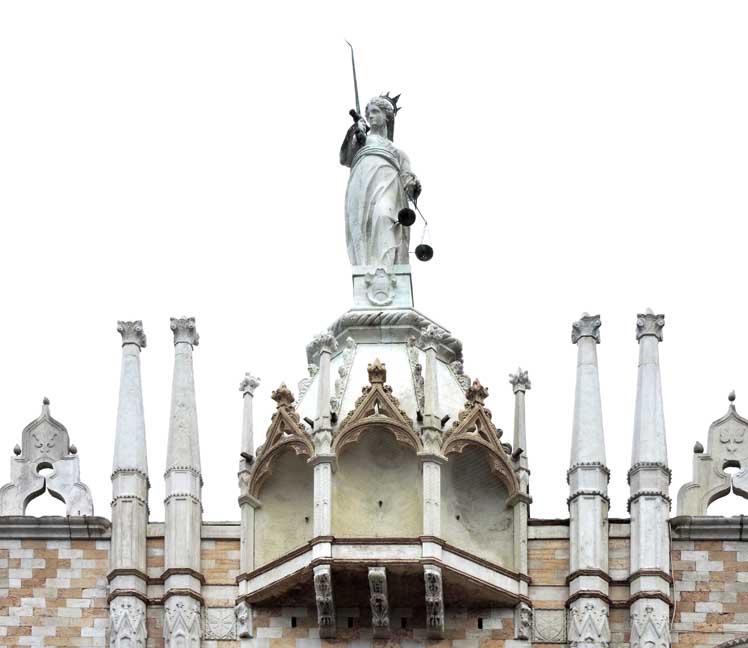 Lady Justice ... Pinnacles ... Merlons 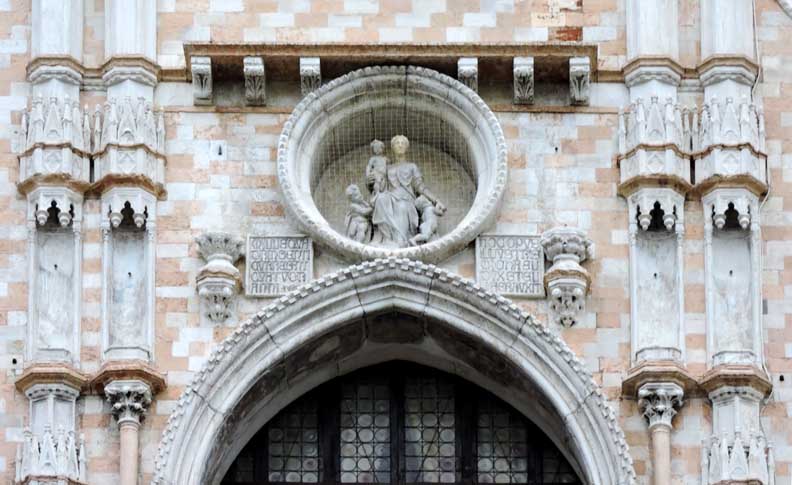 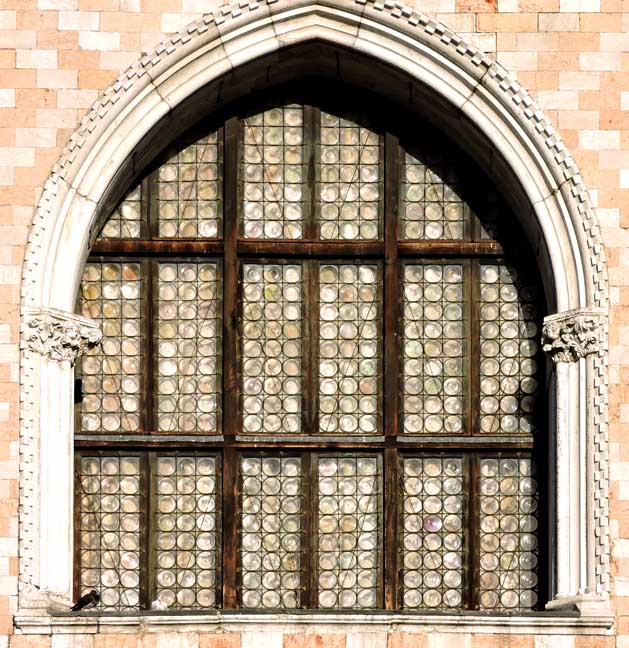 Gothic pointed window with bottle bottom glass 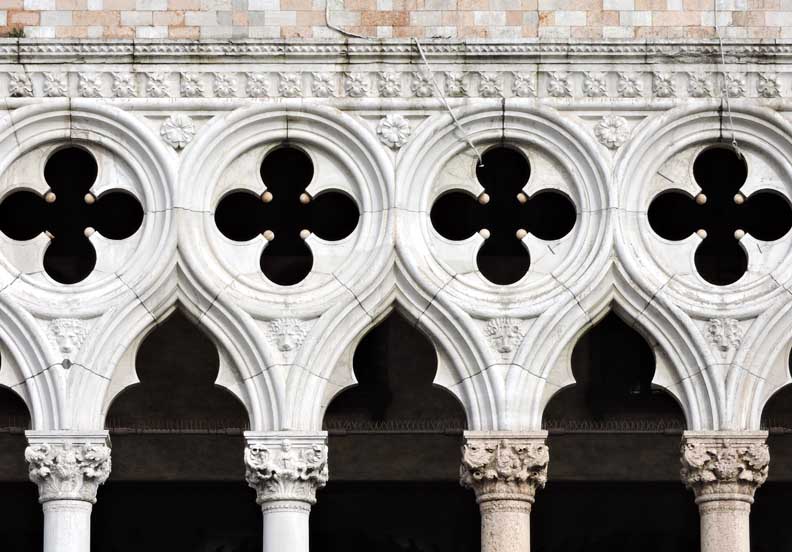 Second story loggia: Gothic quatrefoils ... Trefoil arches ... Carved capitals "Pointed arches and quatrefoils were typical features on Gothic buildings, but the pointed arches bow out [sideways] beneath their peaks, in the manner of Islamic horseshoe arches. We also see tripartite lobes [trefoils]within the arches of the balcony that resemble a similar trend in Islamic architecture. - Dr. Ellen Hurst, "Palazzo Ducale," pub. on Kahn Academy (online Jan. 2017) 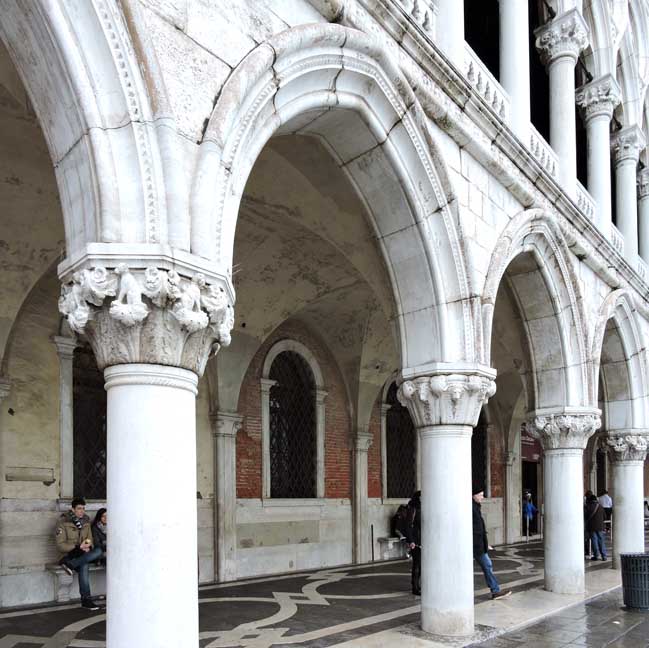 Note capitals which are detailed below: 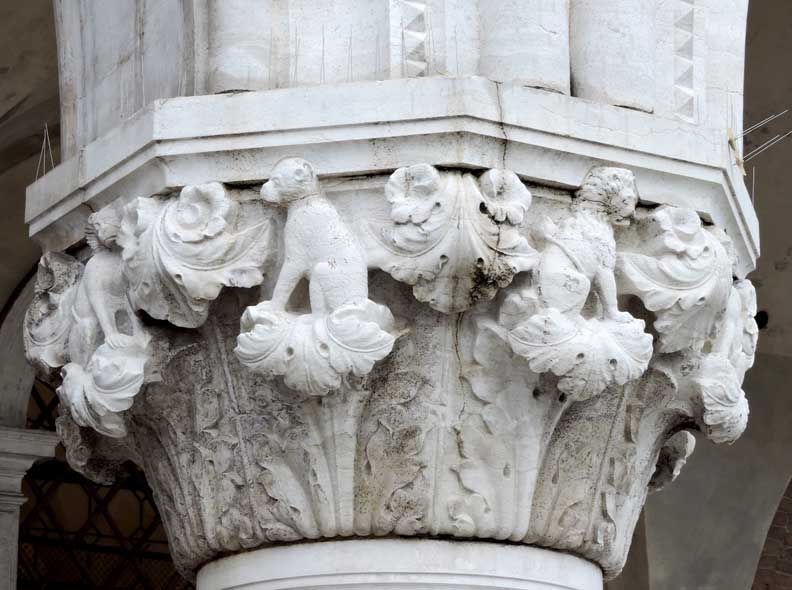 Capital: Dog ... Lion ... Acanthus leaves 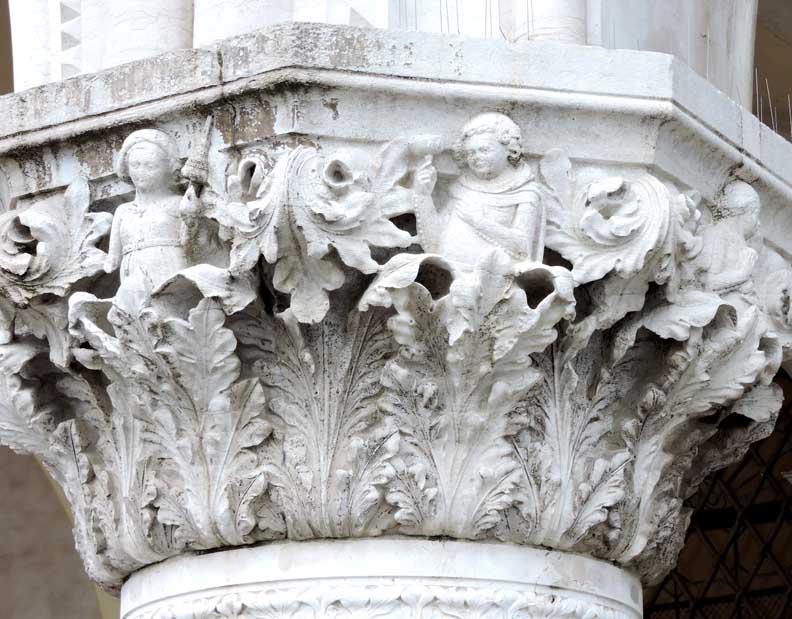 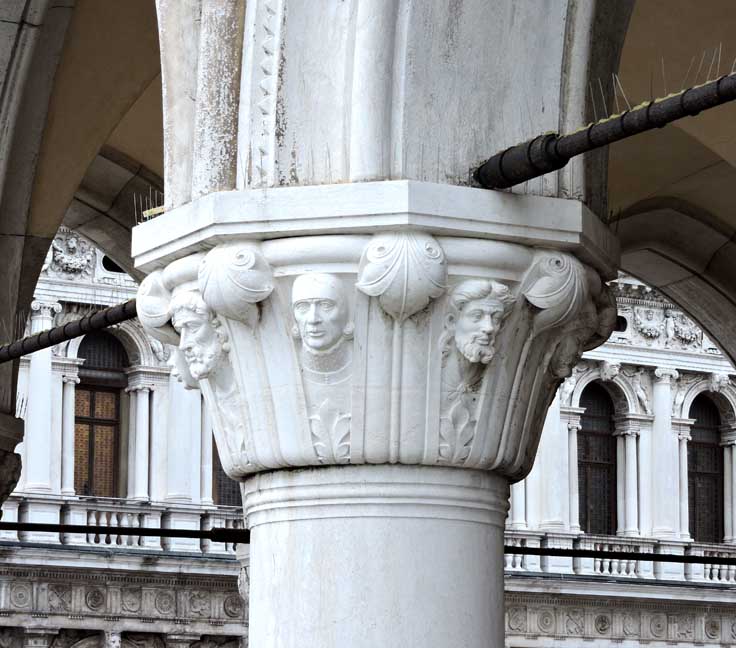 Note tie rods 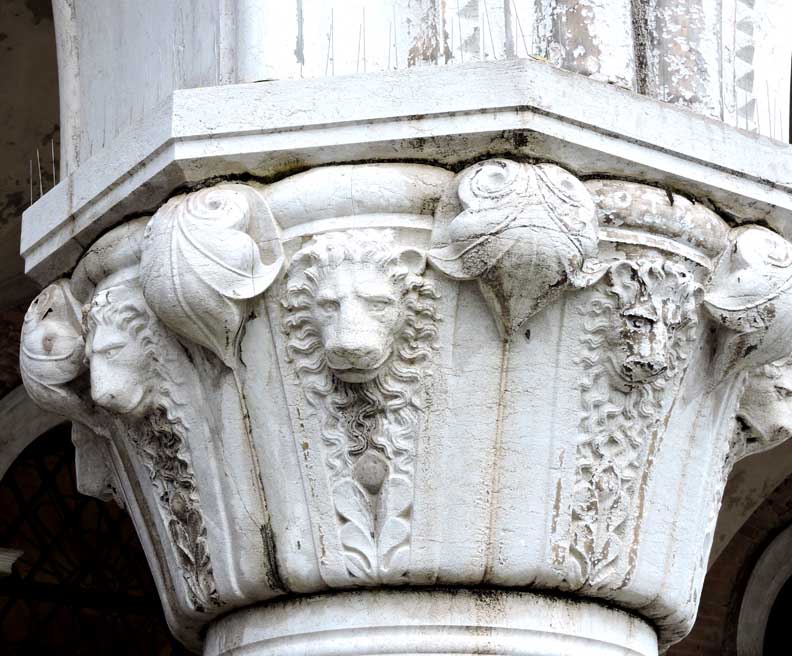 Capital: Lion heads 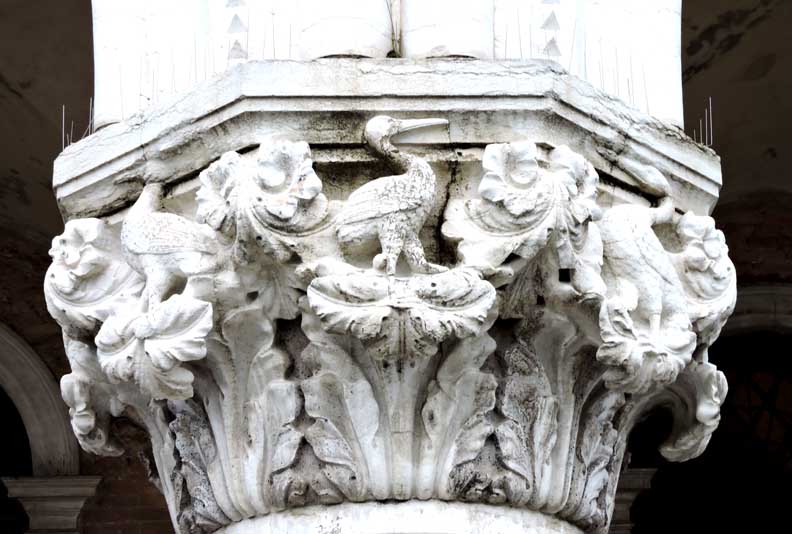 |
Piazzetta San Marco / St. Mark's Square 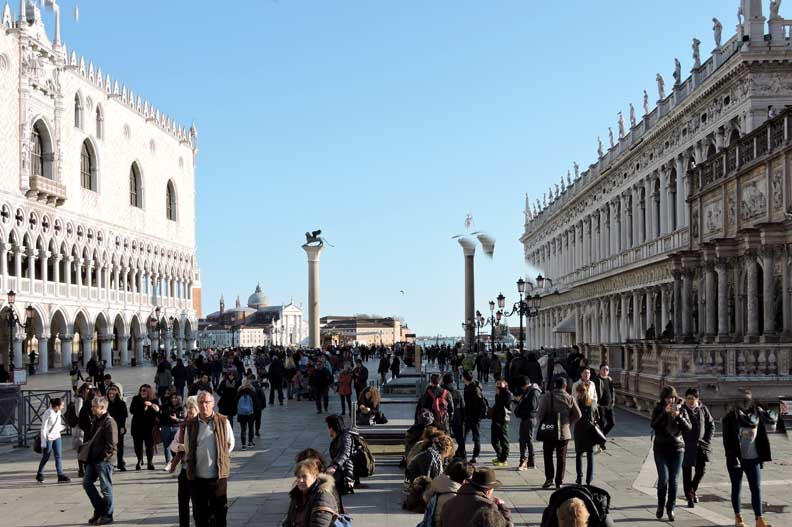 Piazzetta San Marco ... The Palace western wing, facing the Piazetta San Marco, was completed in 1450. The architectural style is generally referred to as Venetian Gothic ... Left background: San Giorgio Maggiore across the lagoon. 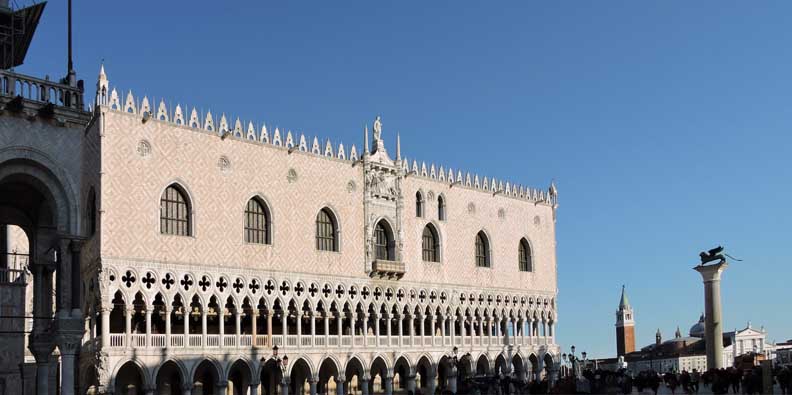 Campanile and church building at right is San Giorgio Maggiore across the lagoon 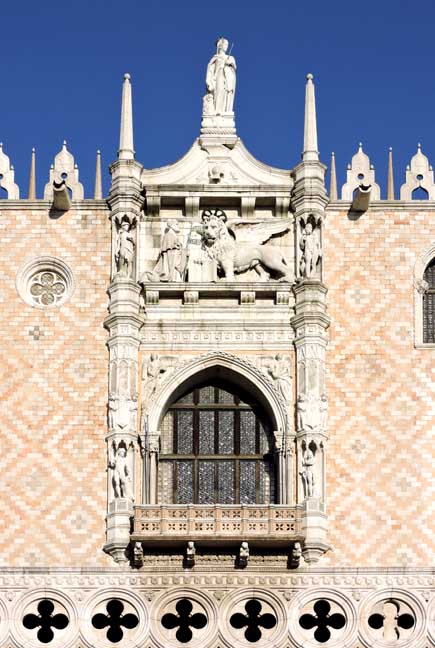 Note Byzantine patterned pink Verona marble ... Three details below: 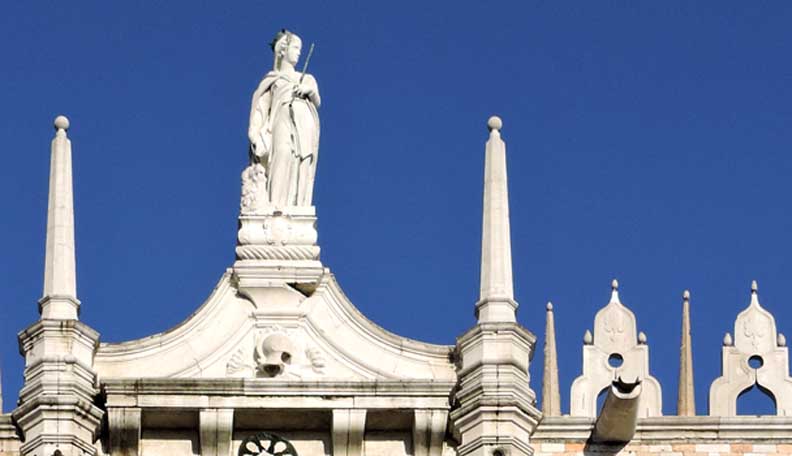 Detail #1 - Finials ... Two merlons ... Scupper 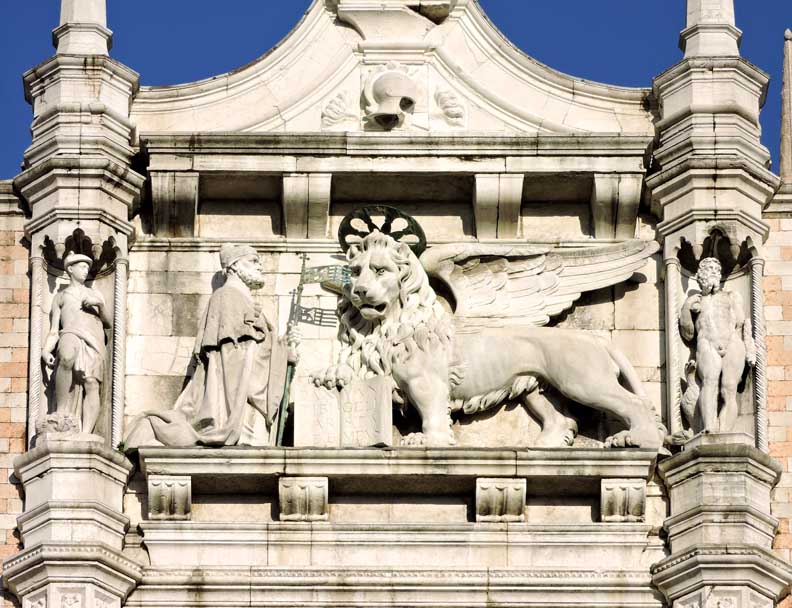 Detail #2 ... Doge kneeling before of the winged lion of St. Mark, symbol of the evangelist, holding a Bible, who is the paton saint of Venice  Detail #3 - Neptune holding his trident |
Courtyard Entrance: Porta della Carta "1438-42. Istrian stone, marble, gilding and paint. The Porta della Carta
with its crowning figure of Justice is the entrance to the court of the
Palazzo Ducale in Venice. The Porta has a simple and effective
iconographic program, with the statue of Justice at the apex. Four
other virtues - Fortitude, Temperance, Charity, and Prudence - occupy
the niches at either side, a bust of St Mark occupies the roundel in
the tympanum, and a portrait of Doge Foscari, removed in the Napoleonic
period and now replaced by a replica, kneels before the lion of St Mark
over the door. The window traceries are as ornate as any to be seen in
Venice." - Web Gallery of Art (online Jan. 2017)
Four details below:"The Porta della Carta, the palace's main entrance, is the link between the Doge's Palace and St. Mark's Basilica, created by the brothers Giovanni and Bartolomeo Bon in the mid-1400s. It is considered one of the two most perfect examples of Venetian Gothic (the other is the Ca' d'Oro). All around it are carved ornamental and allegorical figures, and above is Doge Francesco Foscari kneeling before the Lion of St. Mark. The symbolism is strong here, showing that in the Venetian Republic the individual bowed to the power of the state. The present sculpture is a 19th-century copy of the original, which was destroyed when Napoleon's army invaded Venice in 1797. The name Porta della Carta means Paper Gate and is thought to have come from those who waited here to hand their petitions to members of the Council. The stump of a column beside the gate was used as a podium for proclaiming laws of the Republic." - Barbara Radcliffe Rogers, "Exploring the Doge's Palace in Venice: A Visitor's Guide," on PlanetWare (online Jan. 2017)  Angel ... Gothic quatrefoils ... Trefoil arches ... Carved capitals 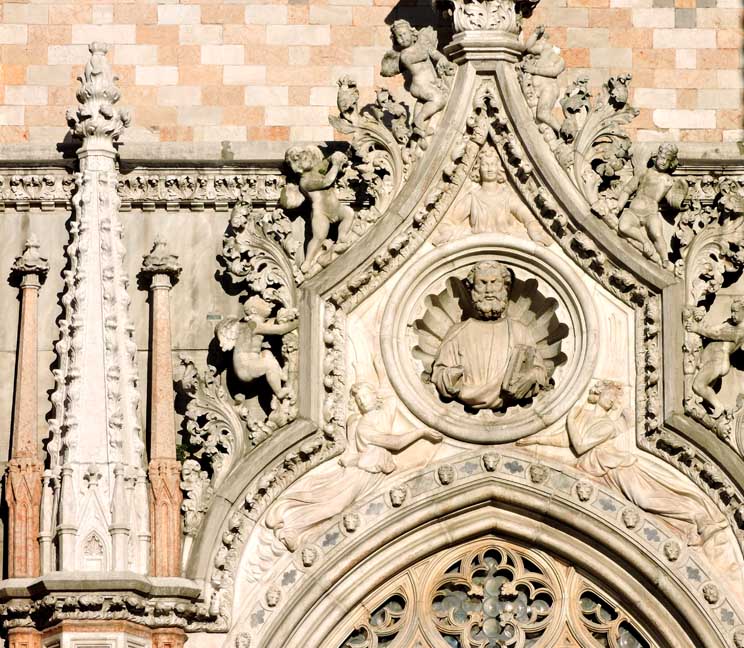 Engaged crocketed pinnacle ... St. Mark occupies the roundel in the tympanum 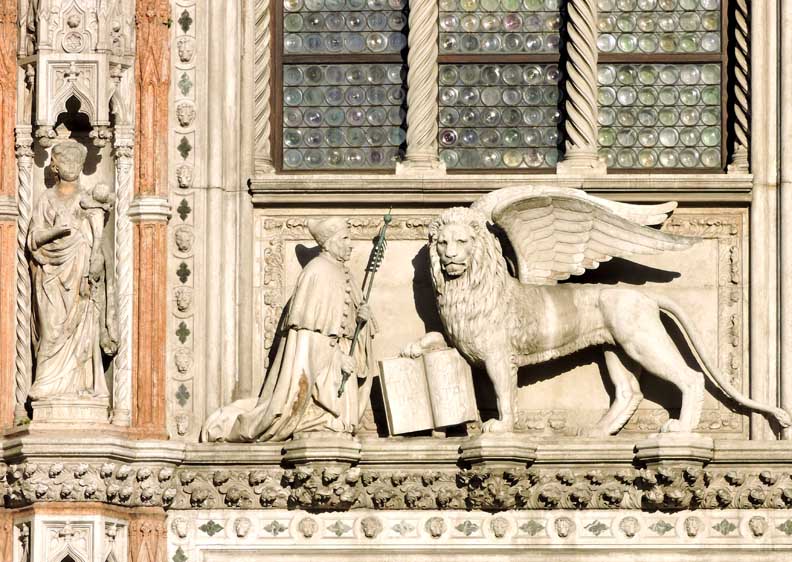 Doge Francesco Foscari, who served during the mid-fifteenth century .... Winged lion of St. Mark, symbol of the evangelist, holding a Bible, who is the patron saint of Venice |
| Doges’ Palace, Italian
Palazzo Ducale, official residence in Venice of the doges, who were the
elected leaders of the former Venetian republic. This impressive
structure, built around a courtyard and richly decorated, was the
meeting place of the governing councils and ministries of the republic.
In its successive rebuildings, the palace incorporated characteristics
of Gothic, Moorish, and Renaissance architecture. The first palace was built in 814 and was burned by the populace in 976. It was reconstructed but was damaged by a second fire; it was begun in its present form in the early 14th century. In 1424 the completion of this Venetian Gothic-style palace was undertaken, and the two identical facades facing the Molo (a broad stone quay) and the Piazzetta San Marco were extended. The Porta della Carta, the main gateway, was designed by Giovanni and Bartolomeo Bon (Buon) and begun in 1438. Severe fires later necessitated rebuilding parts of the palace. - Encyclopaedia Britannica (online Jan. 2017) |
| By the fourteenth century, the
hierarchy of Venice decided that a grand palace was needed, a building
befitting the city's new wealth and power. Designs for the Doge's
Palace were created by Filippo Calendario (who was later executed for
treason in 1355) and work on the structure began. Because of Calendario's death, the Palazzo Ducale was constructed in two phases. The eastern wing, which faces the Rio di Palazzo, was built between 1301 and 1340. The western wing, facing the Piazetta San Marco, took an additional 110 years to build and was completed in 1450. The architectural style is generally referred to as Venetian Gothic - a gothic structure with byzantine influences. - A View On Cities (online Jan. 2017) |
|
Venice in the fourteenth century Today, we think of Italy as a unified country. But in the fourteenth century, the major urban centers of Italy were largely unstable. Wars were common. Rivaling families sought to oust their opponents - often by violent means - and seize power for themselves. This is why so much civic architecture of the Renaissance period is imposing and fortress-like. Buildings like Florence’s Palazzo Vecchio were the standard for civic buildings in Italy well into the fifteenth century. Things were different in Venice. The city was politically more stable than other Italian centers, and it was also naturally protected from invasion by its favorable setting in a lagoon on the Adriatic Sea. As a result, Venice’s architecture did not need to be as defensive as the architecture of neighboring regions. This allowed for greater experimentation in architectural form evident in the Palazzo Ducale, constructed beginning in 1340, for the elected ruler of Venice. A new palace for the doge Fourteenth-century Venice was an oligarchy, meaning that it was ruled by a select group of elite Venetian merchants. The main elected ruler was called the “doge,” and his residence was - much like the White House in the United States - a private residence and also a place for official business. Although there was already a residence for Doge Gradenigo in the 1340s, the system of government changed afterwards so that more people were involved in governmental activities. This required more space than was available in the existing palace, the great council (a political body consisting of the nobility) voted to extend the palace. Workers began construction in 1340 and continued into the early part of the fifteenth century. The Palazzo Ducale sits in a prominent location. It is adjacent to the Basilica of St. Mark (Venice’s cathedral church), on St. Mark’s Square. The Ducale also overlooks the lagoon, which was a major point of entry into the city. Its prominent location made it (and continues to make it) an important symbol of Venetian architecture. It offered visitors one of their first impressions of the city. The building appears delightfully open and ornamental precisely because it is able to forego many elements of defensive architecture. The facade includes three levels: a ground-level loggia (covered corridor) defined by an arcade of pointed arches. The second level contains an open balcony which features a prominent balustrade (railing) that divides the first and second stories. Like the lower loggia, the balcony features pointed arches, though here with the addition of delicate quatrefoils (four-lobed cutouts) just above them. A stone wall completely encloses the third and uppermost level of the facade and is punctuated by a row of large, pointed windows. In many respectses - especially in its horizontal emphasis and three-story facade - the exterior of the Palazzo Ducale exhibits features that emerged in the Renaissance architecture of Florence during the fifteenth and sixteenth centuries. One could argue that this building anticipates those trends. Undoubtedly, in the Palazzo Ducale, we see a degree of the harmony and rhythm that we associate with later Italian Renaissance architecture. |
